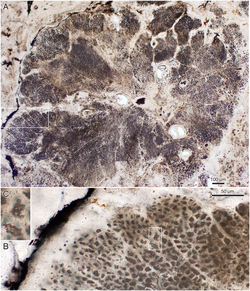Biology:Ramathallus
| Ramathallus | |
|---|---|

| |
| thin section of holotype | |
| Scientific classification | |
| (unranked): | Archaeplastida |
| Division: | Rhodophyta |
| Class: | Florideophyceae |
| Genus: | †Ramathallus Bengston, 2017 |
| Species: | †R. lobatus
|
| Binomial name | |
| †Ramathallus lobatus Bengston, 2017
| |
Ramathallus is a genus of sessile lobate alga that represents a probable stem-Rhodophyte from the Proterozoic.[1] The holotype of Ramathallus lobatus shows a cell structure with finger-like protrusions and a coating of non-cellular apatic. The cells have a dark granular material inside of them.[1] The organism grew by apical growth and possessed pseudoparenchymatous thallus which in turn infer a possible affinity with the Florideophyceae. Many lobate protrusions radiated from the organisms centre composed out of pseudoparenchymatous tissue interpreted as "Cell fountains" made up of variably-sized cells. Ramathallus shares a close morphological similarity with the Ediacaran genera made up of pseudoparenchymatous, lobate fossils from the Doushantuo phosphorites of China Thallophyca, Thallophycoides, Paramecia and Gremiphyca.[1]
See also
References
- ↑ 1.0 1.1 1.2 Bengtson, Stefan; Sallstedt, Therese; Belivanova, Veneta; Whitehouse, Martin (2017). "Three-dimensional preservation of cellular and subcellular structures suggests 1.6 billion-year-old crown-group red algae". PLOS Biology 15 (3): e2000735. doi:10.1371/journal.pbio.2000735. PMID 28291791.
Wikidata ☰ Q115802033 entry
 |

